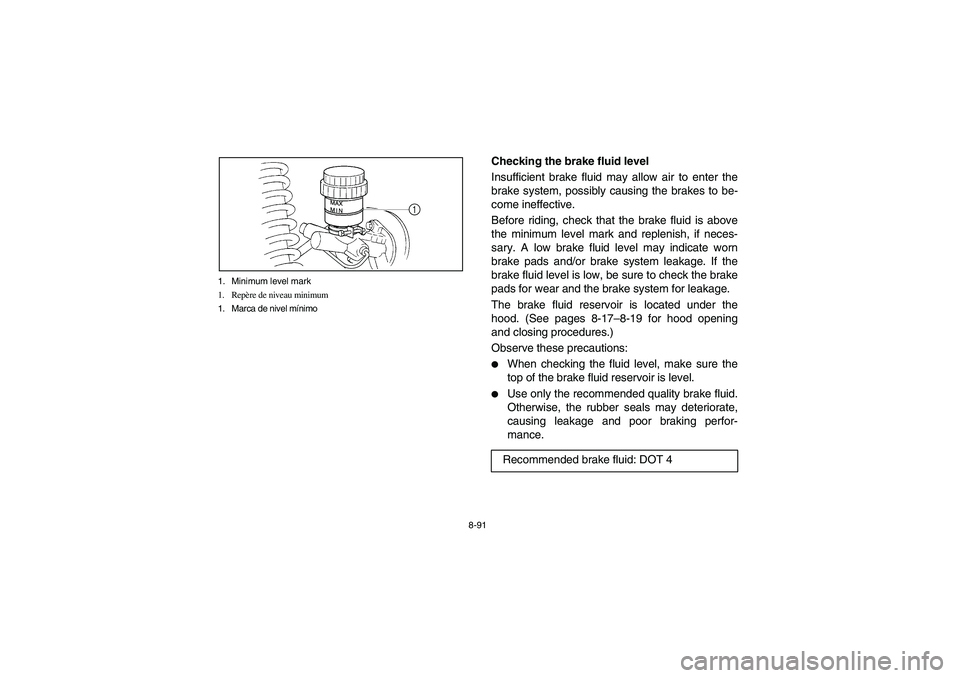Page 270 of 490
7-57
Slow down when you reach the crest of the hill if
you cannot see clearly what is on the other side –
there could be another person, an obstacle, or a
sharp drop-off.
If you start to lose traction or momentum when
climbing, and decide you will be unable to contin-
ue, use the brakes to stop. Do not attempt to turn
the vehicle around. With your foot on the brake
pedal, look behind you and plan your descent.
Shift the drive select lever into reverse so you can
use engine braking to slow your descent. Release
the brake and begin to coast down the hill. Use en-
gine braking as much as possible, gently applying
the brakes when necessary.
EE.book Page 57 Wednesday, November 7, 2007 2:40 PM
Page 272 of 490
7-59
Downhill
Check the terrain carefully before going downhill.
When possible, choose a path that lets you drive
your vehicle straight downhill. Choose your path
carefully and drive slowly enough to be able to re-
act to obstacles that you encounter.
For more traction and control, before going down
steeper and/or rougher slopes, shift into low gear
and select 4WD or 4WD Diff. Lock. Engine braking
will help you go downhill slowly. Go as slowly as
possible. If you begin to go too fast, apply the
brakes gently. Avoid hard application of the
brakes, which could cause the vehicle to slide.
EE.book Page 59 Wednesday, November 7, 2007 2:40 PM
Page 278 of 490
7-65
Water
If you must cross shallow, slow-moving water up to
the depth of the vehicle’s floorboards, choose your
path carefully to avoid sharp drop-offs, large rocks,
or slippery surfaces that could cause the vehicle to
overturn. Never operate through water deeper
than 33 cm (13 in) or fast-flowing water. Choose a
path where both your entrance into and exit point
from the water is a gradual incline. Determine the
water depth and currents before crossing.
Operating this vehicle through deep or fast-flowing
water can lead to loss of control or overturn. To re-
duce your risk of drowning or other injuries, use
care when crossing through water.
Wet brakes may have reduced effectiveness. After
leaving the water, test your brakes. If necessary,
apply the brakes several times to let friction dry out
the linings.
EE.book Page 65 Wednesday, November 7, 2007 2:40 PM
Page 372 of 490
8-85
Brakes
Replacement of brake components requires pro-
fessional knowledge. Brake service should be per-
formed by a Yamaha dealer.
WARNING
Operating with improperly serviced or adjust-
ed brakes could lead to a loss in braking ability
and an accident.
EE.book Page 85 Wednesday, November 7, 2007 2:40 PM
Page 378 of 490

8-91 1. Minimum level mark
1. Repère de niveau minimum
1. Marca de nivel mínimo
1
EVU00850
Checking the brake fluid level
Insufficient brake fluid may allow air to enter the
brake system, possibly causing the brakes to be-
come ineffective.
Before riding, check that the brake fluid is above
the minimum level mark and replenish, if neces-
sary. A low brake fluid level may indicate worn
brake pads and/or brake system leakage. If the
brake fluid level is low, be sure to check the brake
pads for wear and the brake system for leakage.
The brake fluid reservoir is located under the
hood. (See pages 8-17–8-19 for hood opening
and closing procedures.)
Observe these precautions:�
When checking the fluid level, make sure the
top of the brake fluid reservoir is level.
�
Use only the recommended quality brake fluid.
Otherwise, the rubber seals may deteriorate,
causing leakage and poor braking perfor-
mance.
Recommended brake fluid: DOT 4
EE.book Page 91 Wednesday, November 7, 2007 2:40 PM
Page 382 of 490
8-95 1. Brake pedal
1. Pédale de frein
1. Pedal de freno
EVU00860
Brake fluid replacement
Complete fluid replacement should be done only
by trained Yamaha service personnel. Have a
Yamaha dealer replace the following components
during periodic maintenance or when they are
damaged or leaking.�
Replace the oil seals every two years.
�
Replace the brake hoses every four years.
EVU01220
Checking the brake pedal
Have a Yamaha dealer check the brakes at the in-
tervals specified in the periodic maintenance and
lubrication chart. There should be no free play in
the brake pedal. The brakes should operate
smoothly and there should be no brake drag. If the
brakes feel soft or spongy, this could indicate air in
the brake system. Have a Yamaha dealer check
the brake system if necessary.
EE.book Page 95 Wednesday, November 7, 2007 2:40 PM
Page 448 of 490
9-3
3. Rinse the dirt and degreaser off with a garden
hose. Use only enough pressure to do the
job. WARNING! Test the brakes after
washing. Apply the brakes several times
at slow speeds to let friction dry out the
linings. Wet brakes may have reduced
stopping ability, increasing the chance of
an accident. NOTICE: Excessive water
pressure may cause water seepage and
deterioration of wheel bearings, brakes,
transmission seals and electrical devices.
Many expensive repair bills have resulted
from improper high-pressure detergent
applications, such as those available in
coin-operated car washers.
EE.book Page 3 Wednesday, November 7, 2007 2:40 PM
Page 461 of 490
10-6
Brakes:
System Front and rear unified
Type front Dual disc brake
rear Dual disc brake
Operation Foot operation
Suspension:
Front suspension Double wishbone
Rear suspension Double wishbone
Shock absorber:
Front shock absorber Coil spring/gas-oil damper
Rear shock absorber Coil spring/gas-oil damper
Wheel travel:
Front wheel travel 185 mm (7.3 in)
Rear wheel travel 185 mm (7.3 in)
Electrical:
Ignition system Transistorized coil ignition (digital)
Generator system AC magneto
Battery type U1L-11
Battery capacity 12 V 28.0 Ah
Headlight type: Krypton bulbModel YXR70FSP2X
EE.book Page 6 Wednesday, November 7, 2007 2:40 PM